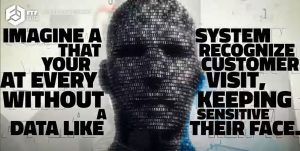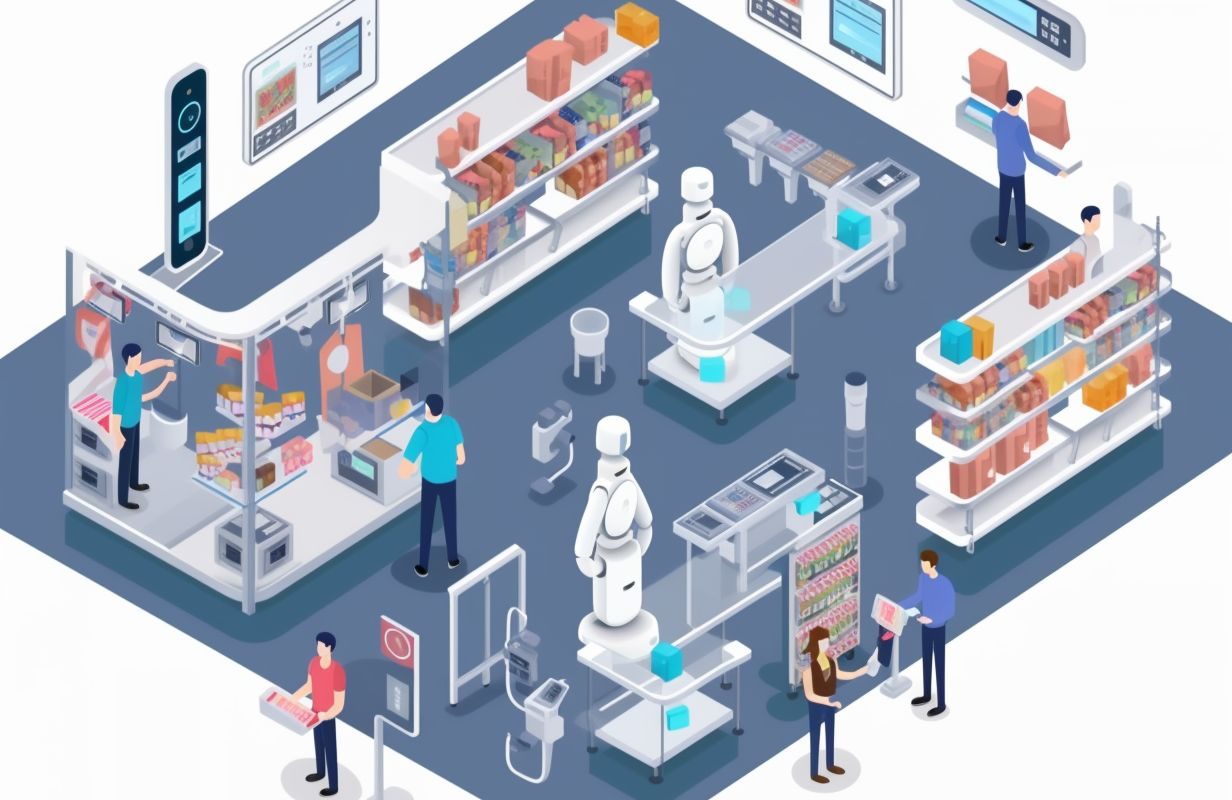Have you ever noticed that as you enter most supermarkets, you’re greeted by a vibrant display of fresh fruits and vegetables?
You take a deep breath in, feeling energised and inspired to make healthy food choices. You grab a cart and begin your shopping trip. Meanwhile, the storekeeper, Mr Lee, watches as customers stream in, their eyes immediately drawn to the colourful produce displays at the front of the store. Mr Lee knows that this strategic placement is not just a coincidence; there is science behind it. Research has shown that people who start their shopping experience with fresh produce tend to make healthier food choices throughout their trip.
Did you know that a simple action like the placement of vegetables using AI technology, can benefit customers and storekeepers both? FTF International AG, a Swiss company working in the AI technology space, has object recognition and people recognition technology which help storekeepers like Mr Lee track and analyse customer behaviour within the store to optimize product placement and inventory management and increase sales, all while maintaining customer satisfaction and anonymity.

FTF’s AI technology works by analysing customer movements and behaviour without collecting any personally identifiable information. The technology uses advanced computer vision algorithms to analyse video feeds from strategically placed cameras within the store. The cameras capture video data of customers moving through the store and interacting with products. The data is processed in real-time, allowing FTF’s system to generate insights on customer behaviour and preferences almost instantly. For example, FTF technology can track which specific vegetable displays attract the most customer attention and adjust accordingly. It can also identify which products are most frequently purchased together, allowing Mr Lee to create more effective product bundles and promotions. Furthermore, FTF’s technology can be integrated with existing inventory management systems, allowing Mr Lee to manage stock levels and replenishment cycles better.
The benefits of placing vegetables first in the store go beyond just promoting healthy eating. It can also have a significant impact on the store’s bottom line:
- Studies have shown that customers who start shopping in the produce section are more likely to purchase additional items, resulting in higher overall spending.
- Having a prominent vegetable display can also increase the perceived value of the entire store, leading to higher customer satisfaction and loyalty.

For example, John, a busy professional, walks into his local supermarket and notices a positive change in the store’s organization and product selection. He is impressed with the personalized recommendations he receives, the reduction in out-of-stock items, and the improved overall shopping experience. Little does he know that these improvements are due to FTF’s object and people recognition technology. John appreciates the fact that his shopping data is being analysed anonymously, which helps the store improve operations without compromising his privacy.
In conclusion, customer-centric strategies like the placement of fresh produce in supermarkets can have a significant impact on both customer experience and the store’s success. FTF‘s object and people recognition technology takes this one step further by optimizing product management and boosting customer experience while maintaining customer anonymity. Overall, the use of AI technology in retail shows how businesses can leverage anonymous customer data to improve their operations while benefiting their customers.




??
??
Really nice reflection, easy and entendable
Durch die Erfahrung als Visual Merchandiserin bei einem renommierten Schweizer Detailhändler, weiss ich, dass das Kauferlebnis entscheidend ist. Bei der Vielfalt an Produkten braucht es eine klare Kundenführung. Dieses Ziel erreichen wir nur, wenn wir wissen, was die Kund:innen anspricht. Es ist also eine win win Situation für die Kundschaft und den Markt. Man kann mit Hilfe dieser Technik den Laden so gestalten, dass diese finden was sie brauchen und ihnen ein einmaliges Kauferlebnis bieten.
Während meiner Ausbildung, durfte ich eine solche Technik am eigenen Leib ausprobieren. Dabei wurden die Pupillen als dunkler Punkt erfasst, mehr war nicht vom Gesicht und Körper zu sehen. Alles in allem kann ich bestätigen, diese Techniken ist sicher und hilfreich.
Vielen Dank, Stephanie, dass Sie Ihre Erfahrungen bei der Arbeit geteilt haben. Diese Technologie wird Unternehmen dabei helfen, ihre Produkte und Dienstleistungen mit hoher Präzision zu verbessern.
Intresting article. Well done Jon!
Solutions with new technologies like AI are impressive and bear huge potential. However, should the focus not lie on providing more local and sustainable produced products instead of providing a growing selection of products based on data?Different technologies bear huge potential, but it is important to think twice why and how we use it, and what value it adds to the society.
Hello Marc,
Thank you for the comment and question.
Whether the selection of products is local or no is a business decision. Therefore, the business also decides the call to stay local or not. The data merely shows which products of the lot are beloved or needed by customers. As it is with most technology, value addition to society is possible with AI but finally, it is up to the business how it decides to act
Dear Jon this is a very interesting and informative article!
Dear Jon,
that’s an amazing post! Impressive what modern technology can do. At some supermarkets nearby my home, they started running these tests as well.
Thank you for your response, Michelle. I am sure this is the future, it all depends on how it is implemented.
Thank you Erina! I am glad that you found this article captivating. The next post will provide more insight into the points discussed in this article.
Nice post, but I’m concerned about security and privacy side of this technology.
Thank you Sofiia. You are not alone in this concern 🙂
I hope to pursue this topic in my future articles… stay tuned!
Wow! I liked your article! Thanks for sharing this useful information.
I am glad that you found my work informative. Stayed tuned for more of such articles 🙂
Creating a personalized offer for customers is important in all areas. Even in the field of daily life, it is important to offer customers more compliant.
Yes Paul, that is true. Using modern technology we can find optimal solutions for customers.
A fine and interesting article about customer-centric strategies! Short and precise. I enjoyed reading it and I am definitely a bit better informed now. Thanks!
You are welcome Patrick. I am sure that you would definitely enjoy the next article also… stay tuned.
Very beautiful article! Thank you for the interesting information!
You are welcome Chiara. I am glad that you enjoyed the article 🙂
Very interesting to read!
Thank you Oliva! It is always interesting to learn differents applications of technology.
It is incredible how technology advances so quickly! And I find it very good that the shops can so adapt to our needs. This way there are more happy customers and less waste.
At the same time, however, I foud it a bit creepy, but I will trust your words on that.
Thank you for sharing your thoughts Lisa. Using technology sometimes comes with the responsibility of handling sensitive user data. I am glad to explore this aspect of technology in one of my articles 🙂
If they really don’t keep the sensitive data, I would definitely appreciate this type of personalized service,
Very interesting!
Yes Samira. I too believe anonymous user data can be effectively used to give personalised service without the risk of giving out personal information. Stay tuned for the upcoming articles as we explore this and other aspects of technology.
Great, this is some of your best work yet! Looking forward the next.
Thank you for your appreciation Gavhar! Stay tuned as we have plans to share even more informative and exciting articles 😉
A very interesting and easy to understand article. The examples match perfectly with the product, which is difficult to understand. My most sincere congratulations
Thank you Bernat for your kind words! Keep checking again to see more of such information being shared.
hi Jon, nice article. I think AI in grocery stores shows promise. Even more so if it can help reduce waste by recognozing which products are less or more needed. I’ll stay tuned for more ✌?
That is the goal of technology! Use resources and develop areas that align with the vision and strategy of the business or organisation.
I find it frightening and fascinating at the same time. In one hand, we are beeing watched. But on the other hand, the technology analyses individual customers anonymously, which is fantastic. Therefore, both parties benefit from the data.
And Jon: Short and to the point. Well done.
Thank you for your comment Nicole.
You hit the nail on the head! The core idea of such posts is to bring to light solutions that keep both, customers’ and business interests in scope. We shall be exploring similar topics and questions in future posts.
Wow, I was really impressed by your article on AI and its impact on retail success! Your insights into object and people recognition technology and its potential to revolutionize the retail industry were really insightful. It’s clear that you have a deep understanding of this subject matter and I learned a lot from reading your post. Thanks for sharing your knowledge and keep up the great work!
I appreciate your enthusiasm for the subject. I invite you to keep checking out my posts as we tackle technology, business cases and customer impact.
Beautiful article Jon! 🙂
In E-commerce, conversion rates are of interest. In other words: The number of website visitors vs. the number of buying visitors. This can be easily measured in the digital space by analysing clicks and entire journeys. Offline stores often need that kind of insight, and with the growing community of online shoppers, offline stores find themselves increasingly under pressure. What can they do? Well, you can only manage what you can measure, right? So the tech you outlined in your article helps shops with the measuring. Shops gain unprecedented and deep insights into customer behaviour. They can now take measures based on that data and optimise marketing activities, product placements, with an obvious target: Increase conversion rate.
Hello Marco,
Your points are precise and are the underlying message of the post. In current times, digital channels are popular and in high use due to convenience and cost reasons. This impact leaves offlines stores in a tough and challenging spot. At times, retail doesn’t seem so profitable due to its physical presence in the world. However, using technologies like the one mentioned in this article, we can shift the tide by making physical presence in the world a major advantage as relevant, and meaningful and moreover anonymous data can be gathered to improve the perceived value of the customer.
I just had a look at the blog 🙂 The blog seems to be well-researched and informative and provides a useful overview of the potential applications and benefits of AI combined with computer vision in the retail industry. I really like how you were creating a story around Mr Lee which makes the topic much more interesting to read!
One potential area for improvement could be the level of detail provided. While you are providing useful examples and insight into applications of computer vision technology, I would like to read more about technical details about how this technology works and its limitations. Another interesting detail would be to name current tests that FTF is doing or has done and what kind of challenges they encountered and how they approached those.
Additionally the blog is focusing primarily on the potential benefits of this technology, without paying a lot of attention to its drawbacks and risks, i.e. privacy concerns. This is also related to my previous point, I’d like to know which algorithmic concepts are used (and how they work) to guarantee the privacy of the customers.
Overall a very nice and informative blog – I’m looking forward to your future publications
Thank you for your response, it’s in-depth and adequately expressed.
Regarding your points, here are my responses:
1. I shall take your input and focus a few future articles on the drawbacks of such technology and link it to how the company FTF deals with them.
2. I’m already working on another article that discusses customer privacy and anonymous customer data.
3. I will also explore if I could include challenges such technology faces and how to overcome them.
Hi Jon,
Thank you very much for this very exciting blog post. I look forward to your next posts.
Thank you for your lovely comment Nora!
Stay posted on the blog to see the upcoming article 😉
Interesting concept, this could definetly benefit the stores and customers. How does it function in terms of customer privacy, considering there may be concerns about things like surveillance and potential data misuse.?
Hello Mabe,
Thank you for your comment.
I agree with your concerns and we will delve into this topic in the next article.
Wow, I had no idea that the location of fruits and veggies in grocery stores could have such a big influence on my purchasing decisions. Knowing that supermarkets are purposefully positioning vegetables near the front of the shop to encourage healthy eating is reassuring for someone who consistently attempts to make healthy food choices.
Have you ever been pleasantly surprised by a store’s personalized recommendations and improved shopping experience?
Hello Sarujan,
I am glad to have brought this piece of information to your notice. It is truly astounding when you think of the impact that small actions (generally not expensive) have on an established industry like supermarkets. I have always seen veggies being placed in the front but I am not sure if they use such technology. I believe this topic could be of significant interest to pursue in a future article. Please visit again to see our follow-up article on this topic 🙂
Apt and accurate details covered!!!!! Great man!!